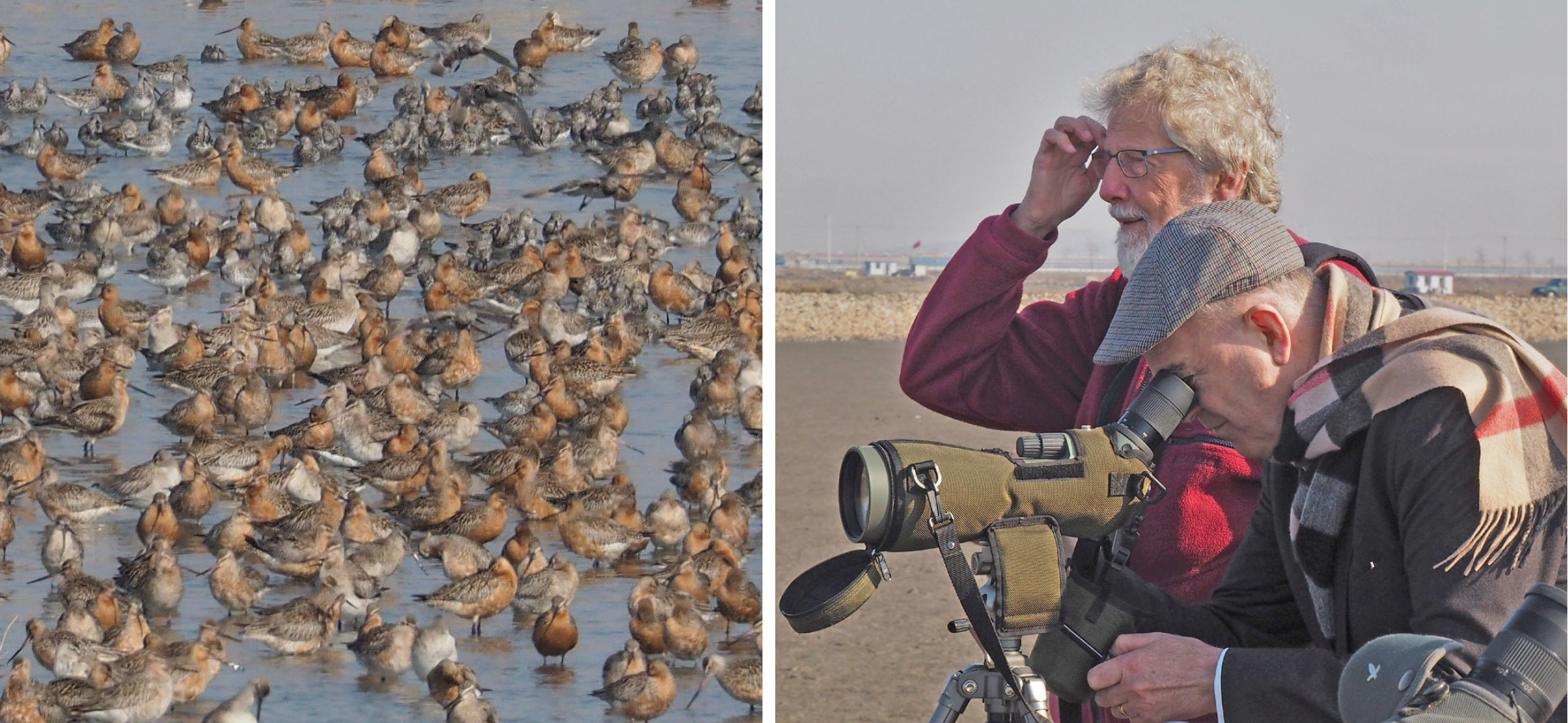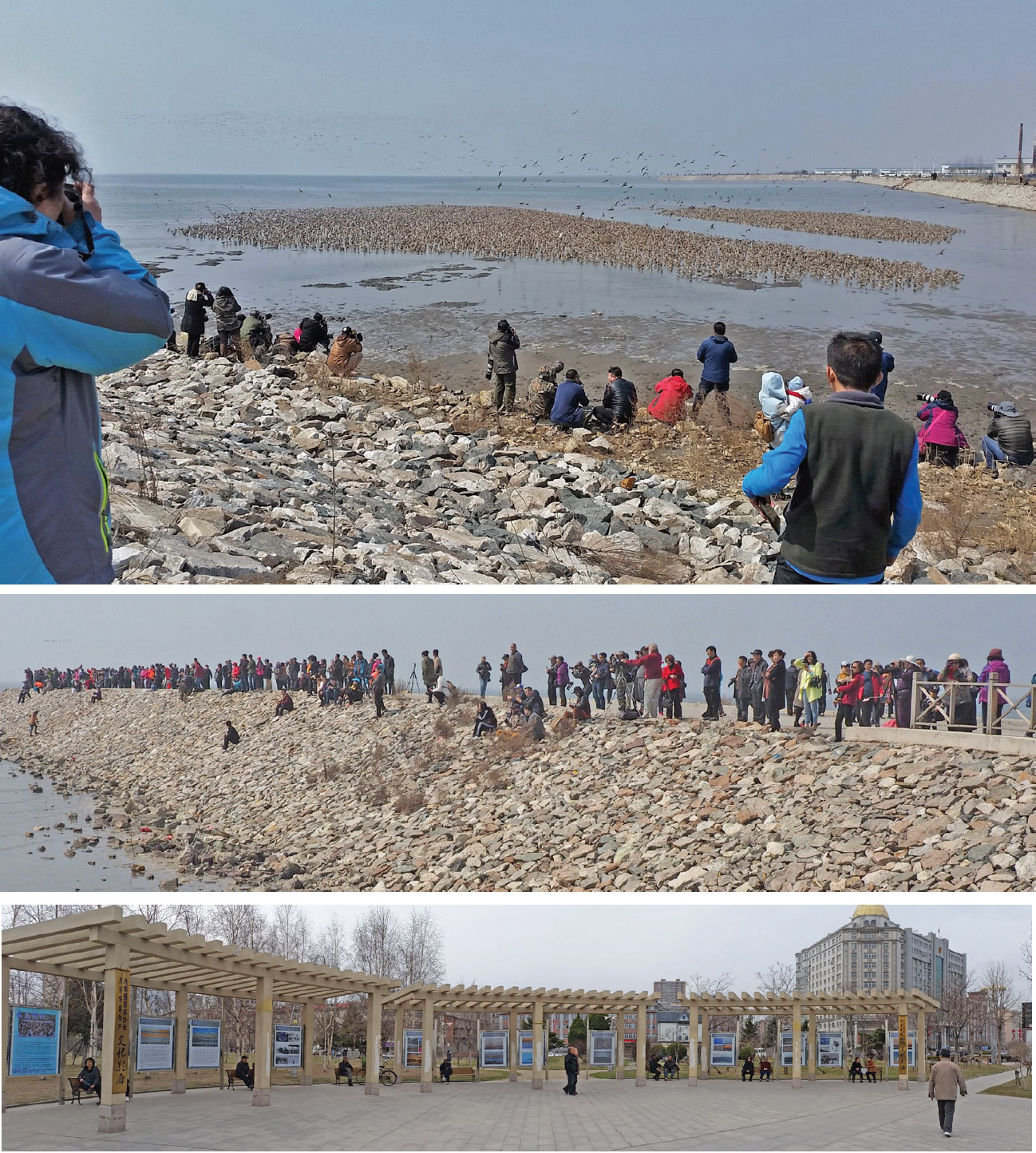
For several years now PMNT has been involved in shorebird surveys in the Yellow Sea region, but this year’s work took on a slightly different angle. As well as completing bird counts, we wanted to try to answer the question of whether or not birds were moving from China to Korea as the tide advanced.
This required teams observing on either side of the border so, while Keith, Adrian and David were on the Korean side of the Yalu River, Estella Lee, Bruce Postill, Wendy Hare and Nigel Milius were at Yalu Jiang.
We arrived in Dandong after flying to Beijing and taking the bullet train from there. The weather was pleasant but spring hadn’t really sprung, trees, for the most part, still very bare, the first leaves and flowers just emerging.
Three days later we took our first recce trip to the eastern end of the Yalu Jiang National Nature Reserve where our efforts were to be concentrated. What a change from when I was last there 10 years ago.
Then we were pretty well the only people present, but now, ‘Godwit watching’, or, more accurately, bird photography, has become a big thing.
Great to see local interest in the shorebirds. Without that, any conser.vation efforts anywhere are a waste of time to my mind. Most people were well behaved, though as far as educating one or two not to yell or throw rocks in order to get those flight shots goes, there is still some work to do.
Less encouraging was the development of the huge Port of Dandong over the last decade, eating up valuable mudflats, though the Yalu Jiang staff had stopped a reclamation in an even more important part of the reserve, Site 2, a little to the west.
You can never win every battle, so good to see that there is some success with the key ones. Sometimes it seems there is no progress, but considering it’s only two decades since Yalu Jiang was identified as a key stopover, it’s actually been quite remarkable.
The outgoing New Zealand Ambassador to China, John McKinnon and his wife Avenal, visited the same day the DPRK team left by train. With the sun shining behind us, little wind, Adrian’s forecast that the tide would push the birds close to the seawall but allow them to remain on the mud proving correct, and the spectacle of several thousand birds (mostly Bar-tailed Godwit, Great Knot and Dunlin) made for a perfect morning.
It was particularly rewarding for the Ambassador as he’d had a rather sub-optimal experience (due to poor weather) in another part of the Yellow Sea with Adrian last year. It was something he had requested to do before his tour of duty ended, and he seemed suitably impressed. Always good to spread the word, especially in such high echelons.
So to the survey itself. As planned, the first three days were spent at the eastern end of the reserve. Even on the highest tide (the middle day of the three) a few thousand birds remained on the mud, but this was the only day we saw what may have been move.ments across the border (identified as birds flying high in the right direction).
This was also the day we recorded our biggest counts, 31,500 Bar-tailed Godwits, 9,500 Dunlin, 7,500 Great Knot plus much smaller numbers of other species.
On other days, birds were seen heading off in the right direction for Korea, but seemed to be heading for roost sites within the port. Of course, they may have been touching down there then heading off again, but with no way of contacting our colleagues, all we could do was record the movements and compare notes later (it turned out they hadn’t recorded anything that looked like it was coming from China).
Our last two scheduled survey days fell on a weekend and, with the weather forecast looking questionable, the reserve staff decided to hold off with their survey until the Monday. We still went out to search for bands and flags around what we had christened “Ambassador Point” (the site we took the Ambassador to), the weather proving excellent, and our rewards plentiful.

During our time at Yalu Jiang, we recorded 59 individually marked Bar-tailed Godwit, including birds banded in New Zealand, Australia, Japan and Yalu Jiang itself, 14 Great Knot, main.ly from NW Australia, but also from Victoria, and other parts of China, and a single Dunlin from NW Australia.
The spectacle of over 40,000 shorebirds wheeling around in close formation must surely be one of the natural world’s greatest sights and one that always stirs the emotions no matter how many times one has seen it.
It’s tempered slightly here by the backdrop of the huge, aforementioned, port of Dandong, a stark reminder of the developments and reclamations affecting many parts of the Yellow Sea, but it is still a truly wondrous sight.
Hopefully, the work of PMNT in this region will help ensure it’s a sight that’s there for future generations to marvel at too.
– Nigel Milius
